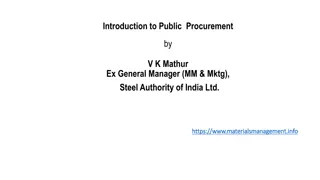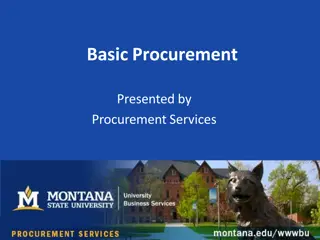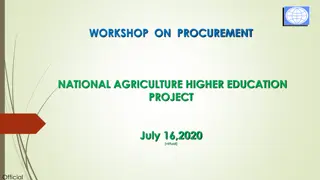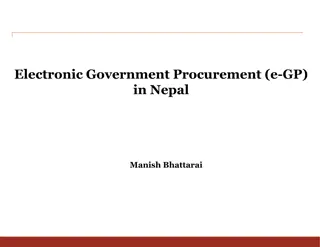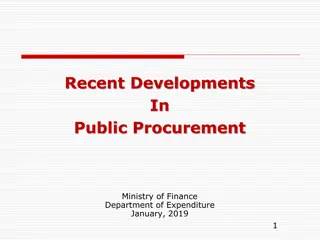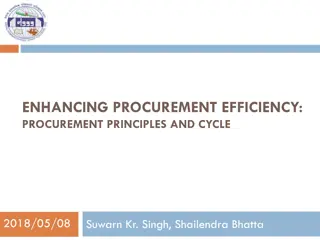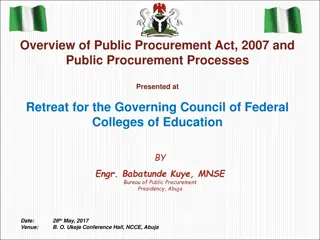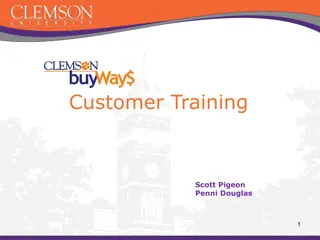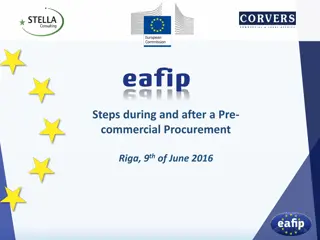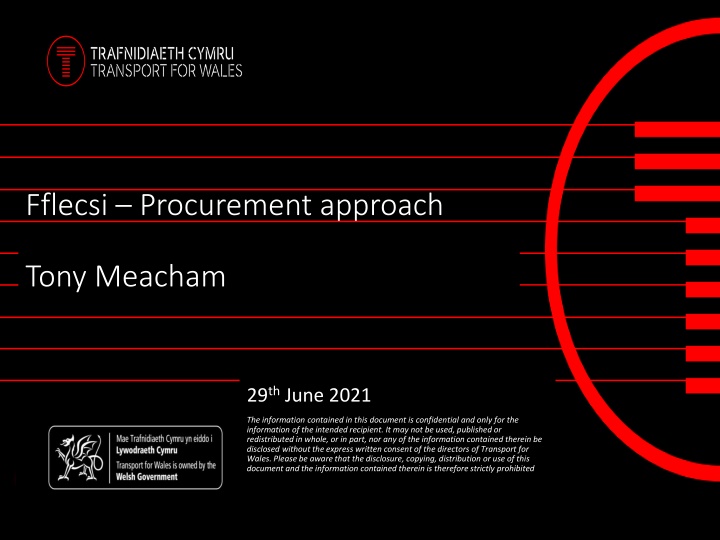
Fflecsi Procurement Structure and Governance Overview
Learn about how Transport for Wales carried out a procurement process for their fflecsi service, including details on market engagement, governance structure, and procurement approach. This overview outlines the importance of stakeholder involvement, bid assessment criteria, and more for a successful procurement process.
Download Presentation

Please find below an Image/Link to download the presentation.
The content on the website is provided AS IS for your information and personal use only. It may not be sold, licensed, or shared on other websites without obtaining consent from the author. If you encounter any issues during the download, it is possible that the publisher has removed the file from their server.
You are allowed to download the files provided on this website for personal or commercial use, subject to the condition that they are used lawfully. All files are the property of their respective owners.
The content on the website is provided AS IS for your information and personal use only. It may not be sold, licensed, or shared on other websites without obtaining consent from the author.
E N D
Presentation Transcript
Fflecsi Procurement approach Tony Meacham 29thJune 2021 The information contained in this document is confidential and only for the information of the intended recipient. It may not be used, published or redistributed in whole, or in part, nor any of the information contained therein be disclosed without the express written consent of the directors of Transport for Wales. Please be aware that the disclosure, copying, distribution or use of this document and the information contained therein is therefore strictly prohibited
Overview TfW carried out a procurement in late 2020 using the Open Procedure under the Public Contract Regulations 2015 This followed an extensive period of informal market engagement. The market engagement was important for several reasons: We needed to understand what it was we actually needed and what was available in the market Once you start an Open Procedure procurement the requirements are fixed, so it s important they are right Through dialogue we were able to develop a healthy relationship with the market which helped them understand what we wanted and whether or not they could meet our requirements
Governance and Organisation TfW has a programme board with a wide range of stakeholders that oversees all activities associated with fflecsi Specifically for the procurement we set up a Procurement Advisory Group (PAG), they oversaw activity and made recommendations for decisions to the programme board The PAG function was important for us, it was made up of key fflecsi stakeholders which gave programme board reassurance PAG recommendations were generally endorsed by programme board without further debate PAG also helped development requirements, evaluation criteria, weightings etc. This again helped with buy in for the procurement as PAG represented all the main stakeholders
Procurement structure The procurement was split into 3 parts: A fairly standard set of mandatory and discretionary reasons for rejection an important aspect of this part was an experience and capability section. This ensured that any bidder who would be carried through to the next part was suitably experienced. For example: Live operation withinthe last 12 months with at least three vehicles operating concurrently in a similar context to the proposed fflecsi service. The vehicles in each case study must operate for a single client and in the same city/geography A live and relevant passenger app available on both Android and Apple app stores that provides functionality to book and manage journeys (real time and pre-booked), show real-time service information (without the need for the user to refresh), manage the customer profile and facilitate in app electronic payment.
Procurement structure We were mindful that bidding can be an expensive commitment for organisations so were keen that only those with a realistic chance of meeting requirements progressed and this requirement did lead to the exclusion of one bidder The second part was a pass/fail assessment of non-functional (IT focused) requirements. Things like ITIL compliance, data storage, server security etc etc. A bidder also failed this section. On reflection we think they hadn t fully understood the rigour of a public sector procurement and the fact that if you fail a mandatory requirement then you cannot proceed. In any further procurement we would likely simplify this second part of the requirements
Procurement structure The third and final part was a demonstration by bidders of their ability to meet the functional requirements There were several reasons we chose this methodology: You can get across in a demo what it would take 000 s of words to say It made it easier for evaluators to assess they could see what was happening in real time and ask for clarification where needed We were aware that the some of the bidder market was not used to public sector procurement and so a written response to requirements may not have got the best out of them The bidders generally took several requirements and turned them into mini case study demos which worked well
Assessment and Evaluation Evaluation was weighted 70% quality and 30% commercial For the quality part bidders were assessed by demonstration of their ability to meet requirements and their development plans where development was required. We didn't asses each requirement individually but groups of requirements otherwise each requirement on its own can become insignificant in scoring terms
Assessment and Evaluation Commercial evaluation was carried out using 3 different growth scenarios, each given a weighting. Scenario prices had to be constructed from unit prices which gave us maximum transparency All evaluation was carried out by consensus scoring following demonstration sessions Contract T&Cs were developed from the Cabinet Office mid tier contract acceptance of T&Cs was a mandatory requirement for bidders
Key learnings for TfW Market engagement and building a relationship with suppliers ahead of procurement is really important Make sure the market understands the obligations/requirements of public sector procurement we sometimes needed to ask very detailed CQs to ensure questions had been answered. It would have been easy to inadvertently trip up bidders Test and retest market understanding of all requirements ahead of finalising procurement documents Make sure non-functional requirements are proportionate and clear Demonstrations worked really well and are something we would do again for this type of procurement

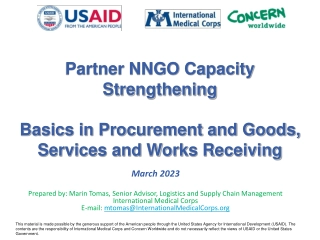
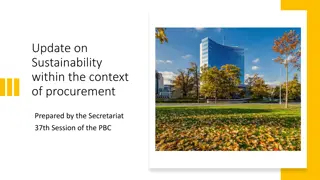



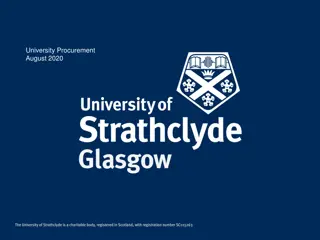
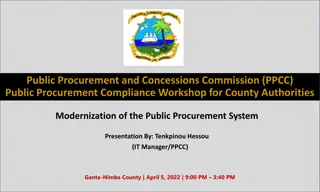
![Comprehensive Overview of Corruption Watch Submission on Public Procurement Bill [B18B-2023]](/thumb/138344/comprehensive-overview-of-corruption-watch-submission-on-public-procurement-bill-b18b-2023.jpg)
